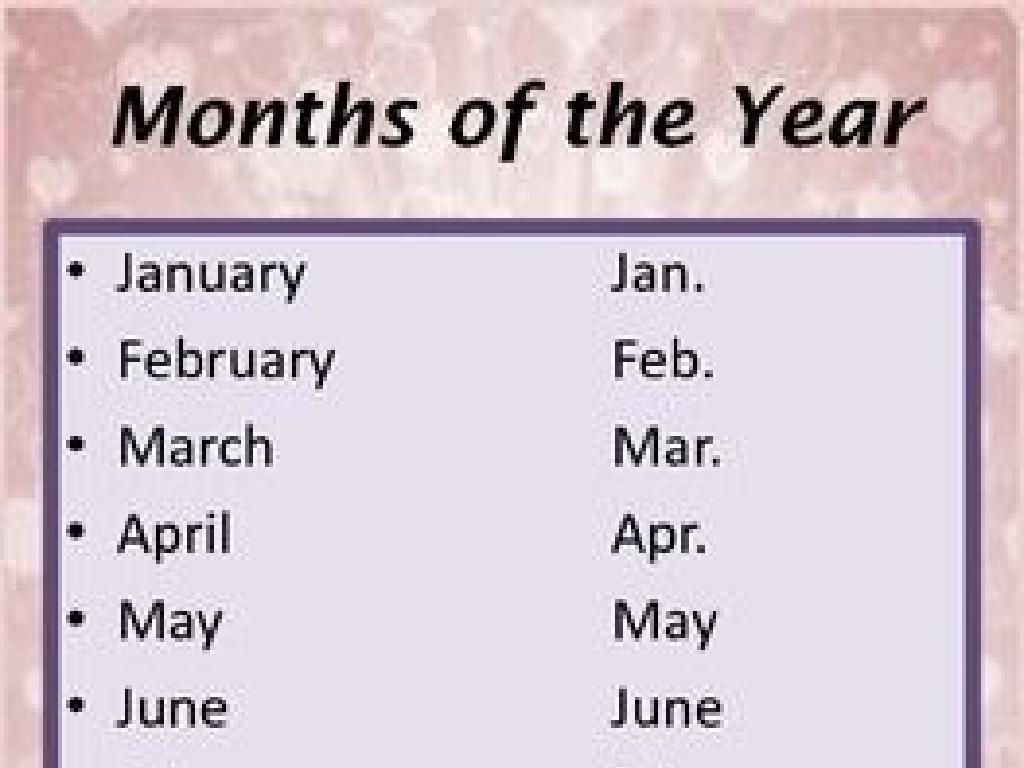Identify The Meaning Of Idioms And Adages: Set 1
Subject: Language arts
Grade: Fifth grade
Topic: Idioms And Adages
Please LOG IN to download the presentation. Access is available to registered users only.
View More Content
Exploring Idioms and Adages
– Define idioms and adages
– Idioms are phrases with a meaning different from the words’ literal meaning, like ‘piece of cake’ means something very easy.
– Purpose of idioms and adages
– Adages are old sayings with a general truth or advice, such as ‘The early bird catches the worm’ meaning success comes to those who prepare well.
– Examples of idioms
– ‘Break the ice’ means to start a conversation in an awkward or tense situation.
– Examples of adages
– ‘Don’t count your chickens before they hatch’ means don’t assume success before it happens.
|
This slide introduces students to idioms and adages, which are integral parts of language arts. Idioms are expressions that don’t mean exactly what the words say, while adages are short, memorable sayings that express a universal truth. They are used to add color and emotion to our language, making it more vivid and expressive. Provide students with common examples to illustrate the meaning and usage of idioms and adages. Encourage them to think of idioms and adages they have heard in conversations or in media. This will help them understand how these phrases enrich our language and make it more engaging.
Understanding Idioms
– What are idioms?
– Idioms are phrases with a meaning different from the words’ literal meaning.
– Idioms make language colorful
– They add fun and imagination to our speech and writing.
– Idioms aren’t literal
– ‘It’s raining cats and dogs’ means it’s raining heavily, not pets falling!
– Examples of common idioms
– ‘Piece of cake’ means something is very easy, not about actual cake.
|
This slide introduces students to idioms, which are phrases where the words together have a different meaning than the dictionary definitions of the individual words. Explain that idioms are used to add expressive color to language, making conversations and writing more interesting. Emphasize that idioms should not be taken literally, as their meanings are figurative. Provide examples like ‘break a leg’ for wishing someone good luck, and ‘spill the beans’ for revealing a secret. Encourage students to think of idioms they have heard and discuss the figurative meanings.
Exploring Adages
– What are adages?
– Adages are short, memorable sayings with a valuable lesson.
– Adages hold timeless wisdom
– They often offer advice or wisdom that is still relevant today.
– Adages: A generational treasure
– Passed down orally, adages become part of our cultural heritage.
– Recognizing adages in language
|
This slide introduces students to the concept of adages, which are short, commonly used sayings that express a universal truth or piece of advice. These sayings have stood the test of time and are often handed down from generation to generation, becoming part of our collective wisdom. Students should understand that adages are more than just phrases; they encapsulate the values and experiences of past generations. Encourage students to think of sayings they’ve heard at home or in their community and discuss the meanings and origins. This will help them to connect with the material personally and recognize the presence of adages in everyday language.
Exploring Idioms: Unveiling Hidden Meanings
– Understanding common idioms
– Idioms are phrases with a figurative meaning different from the literal words.
– The true meaning behind idioms
– For example, ‘spill the beans’ means to reveal a secret, not dropping beans.
– Interactive game: Guess the idiom
– Students guess idioms’ meanings before they’re revealed.
|
This slide is aimed at helping students understand that idioms are phrases where the words together have a different meaning than the dictionary definitions of the individual words. Start by explaining a few common idioms and their meanings. Then, engage the class with an interactive ‘Guess the meaning’ game where students try to infer the meaning of idioms based on context clues from sample sentences. This activity will help students realize that idioms must be understood as a whole rather than through the meaning of individual words. Encourage participation and provide hints if necessary. This will prepare them for reading and understanding idioms in literature and daily conversations.
Exploring Adages: Unveiling Wisdom
– Understanding common adages
– An adage is a short, wise saying, like ‘The early bird catches the worm.’
– Wisdom within the words
– Adages often have a deeper meaning than what’s on the surface.
– Interactive adage quiz
– Test your knowledge: decide if the meanings guessed are correct.
– Engage with true or false questions
|
This slide aims to introduce students to the concept of adages, which are short, memorable, and often philosophical sayings that express a truth or piece of advice. Start by explaining what adages are and provide familiar examples. Discuss the deeper meaning behind each adage and how they apply to everyday life. Engage the students with an interactive ‘true or false’ quiz to test their understanding of the meanings behind various adages. This activity will help reinforce their learning and make the lesson more dynamic. Encourage students to think critically about the adages and whether the commonly associated meanings truly reflect the wisdom they convey.
Exploring Idioms and Adages in Literature
– Discover idioms and adages in reading
– Authors’ use of idioms and adages
– Idioms and adages add flavor to writing, making stories more relatable and vivid.
– Class activity: Find idioms in a story
– Read a short story together and highlight idiomatic phrases and adages.
– Discuss the meaning behind them
– Why do you think the author chose these sayings? What do they add to the story?
|
This slide introduces the concept of idioms and adages within the context of literature. Students will learn how these phrases enrich storytelling by adding depth and cultural significance. The class activity involves reading a short story and identifying idiomatic expressions and adages used by the author. This exercise will help students understand how these phrases can convey complex ideas in a simple way and add a layer of meaning to the text. Teachers should prepare a list of common idioms and adages, provide a short story that contains several examples, and guide the discussion on their meanings and the reasons authors might use them. Possible activities include students working in groups to find idioms and adages in the story, creating their own sentences using the identified phrases, or illustrating an idiom or adage to show its literal versus figurative meaning.
Crafting Original Idioms and Adages
– Create your own idioms and adages
– Combine words in a new way to make a special phrase with a hidden meaning.
– Share your expressions with classmates
– Present your sayings to the class and explain the meaning behind them.
– Discover the impact of unique sayings
– Learn how these phrases can make communication more colorful and effective.
– Reflect on the use of idioms and adages
– Think about how idioms and adages add flavor to language and our daily conversations.
|
This slide encourages students to engage with idioms and adages creatively by inventing their own. It’s a fun activity that helps them understand how these expressions work and why they’re important in language. Students should think about the figurative meaning behind the phrases they create and be prepared to explain their creations. This exercise will also help them appreciate the richness idioms and adages bring to language. In the next class, students will have the opportunity to share their work, fostering a sense of community and enhancing their public speaking skills.
Class Activity: Idiom and Adage Hunt
– Find and illustrate idioms and adages
– Look for common phrases with non-literal meanings
– Work in groups for the activity
– Collaborate to understand and visualize the expressions
– Share findings with the class
– Present your group’s idioms and adages
– Discuss the meanings together
– Explore different interpretations as a class
|
This activity is designed to help students understand idioms and adages by finding them in texts or everyday language and creating illustrations that represent their meanings. Divide the class into small groups and provide examples of idioms and adages. Each group will search for these expressions, discuss their figurative meanings, and create drawings to depict them. Afterward, groups will present their findings to the class, explaining the literal and figurative meanings of each phrase. This will foster a deeper understanding of how idioms and adages enrich language. Possible activities: illustrating ‘It’s raining cats and dogs’ or ‘A penny for your thoughts’. Encourage creativity and ensure each student participates in the discussion.
Wrapping Up: Idioms and Adages
– Review of today’s idioms and adages
– We revisited phrases like ‘Piece of cake’ and ‘Break a leg’
– Understanding idioms and adages
– They’re not literal; they express ideas in a fun way
– Significance in daily language
– Helps with reading comprehension and creative expression
– Looking forward to more Language Arts
– Get excited for more linguistic treasures next time!
|
This slide aims to consolidate the students’ learning about idioms and adages. Start by recapping the expressions covered in the lesson, such as ‘Piece of cake’ for something easy, and ‘Break a leg’ as a way to wish someone good luck. Discuss why it’s important to understand these phrases: they enrich language, making communication more vibrant and expressive. They also appear frequently in literature, so recognizing them aids in understanding the text better. Finally, build anticipation for the next class by hinting at more exciting language concepts to explore. Encourage students to listen for idioms and adages at home or in media as a fun homework activity.





